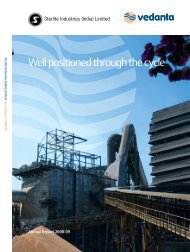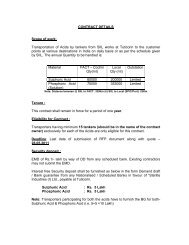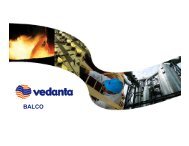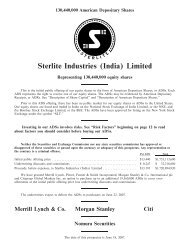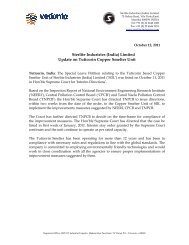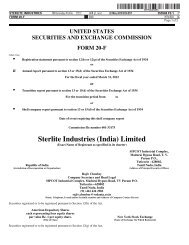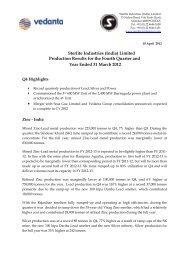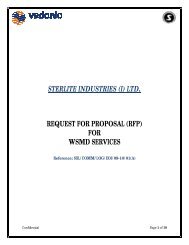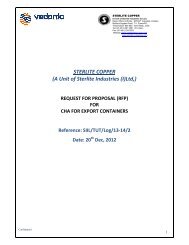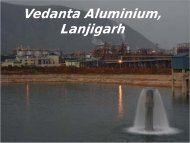Sterlite Industries (India) Limited - Sterlite Industries India Ltd.
Sterlite Industries (India) Limited - Sterlite Industries India Ltd.
Sterlite Industries (India) Limited - Sterlite Industries India Ltd.
You also want an ePaper? Increase the reach of your titles
YUMPU automatically turns print PDFs into web optimized ePapers that Google loves.
The principal deposits in the Mt. Lyell region are all of the volcanic disseminated pyrite-chalcopyrite type, which accounts for 86% of the<br />
known ore in the region. The geology of the Mt. Lyell mine consists of a series of intercalated felsic to mafic-intermediate volcanics.<br />
Lithologies are highly altered quartz-sericite-chlorite volcanics with individual units delineated largely by the relative abundance of<br />
phyllosilicates. Volcaniclastic and rhyolitic lithologies occur sporadically throughout the sequence, as does pervasive iron mineralization in the<br />
form of haematite, magnetite and siderite.<br />
Chalcopyrite is the principal ore mineral and occurs chiefly in higher grade lenses enveloped by lower grade halos. The overall structure of<br />
Mt. Lyell is that of a steeply dipping overturned limb of a large anticline. The hanging wall (stratigraphic footwall) of the ore body consists of<br />
weakly mineralized chloritic schists with disseminated pyrite. The footwall is sharply defined by the Great Lyell Fault — Owen Conglomerate<br />
contact which truncates the ore body at its southern end.<br />
All mining operations at CMT are undertaken by contractors while the processing and mill maintenance operations are undertaken by CMT<br />
employees. A sub-level caving underground mining method is used at the Prince Lyell ore body. Ore is loaded into trucks by front end loader<br />
at draw points and then transported to the underground crusher and skip loading area. Crushed ore is then hauled via the Prince Lyell shaft and<br />
unloaded onto a conveyor feeding the ore bin at the Mt. Lyell processing plant. At the processing plant, the ore is crushed and ground prior to<br />
processing by floatation to produce copper concentrate, which is then filtered to form a cake and trucked to the Melba Flats railway siding for<br />
transport to the port of Burnie. The concentrate is stored at Burnie until it is loaded into ships for transport to the port of Tuticorin in south<br />
<strong>India</strong> from where it is trucked to the Tuticorin smelter.<br />
The tailings dam is a valley-fill type and excess water is discharged via a spillway. The water quality is sampled before the water is released<br />
from the site. The tailings are deposited on beaches some 300 meters from the dam spillway. CMT’s accepted closure plan is to flood the<br />
tailings which will require CMT to raise the tailings dam wall.<br />
CMT has an active exploration and evaluation program at Mt. Lyell which involves upgrading resources below the Prince Lyell reserves<br />
and testing additional exploration targets on the mining lease. The Western Tharsis deposit lies to the west of the Prince Lyell ore body, but<br />
CMT has not yet committed to its development. Additional targets include Tasman & Crown, Glen Lyell, Copper Clays and NW Geophysics.<br />
The processing plant is approximately 30 years old and has been partially refurbished following our acquisition with the addition of<br />
crushers, a float cell and a regrind mill at the surface. While the condition of the plant is ageing, maintenance is carried out as required to<br />
ensure that the process plant remains in safe and efficient condition.<br />
Power at the mine is supplied through an electricity supply agreement with Aurora Energy Pty <strong>Ltd</strong> to supply approximately 112 GW per<br />
hour at a combination of fixed and variable rates until September 30, 2010. There is a plentiful supply of water from mine water and storm<br />
water captured on the tailings dam.<br />
The gross value of fixed assets, including capital works-in-progress, was approximately AUD 102.4 million (Rs. 3,617.4 million or<br />
$71.1 million) as of March 31, 2009.<br />
In fiscal 2009, Mt. Lyell mined and processed 2.4 million tons of ore at a grade of 1.3% copper to produce 98,761 dmt of copper<br />
concentrate, which also contained 15,675 ounces of gold and 135,953 ounces of silver. Although the grade of copper at Mt. Lyell is low, it<br />
produces a clean concentrate that is valuable in the smelting process. Based on reserves as of March 31, 2009 and anticipated production, the<br />
estimated mine life at Mt. Lyell is approximately four years from April 1, 2009.<br />
The economic cut-off grade is defined using the metal prices of $3,889 per ton of copper and $800 per ounce of gold. The cut-off grades are<br />
based on copper grades with the gold credit deducted from the operating costs. The reserves are derived from stopes which are designed such<br />
that the limits of the stope are defined by a cut-off grade of 1.0% copper and have an average grade that exceeds 1.0% copper. The revenue<br />
derivation of the cut-off grade includes the gold credit. The break-even cut-off grade of 0.75% copper is the grade that makes enough margin to<br />
cover the fixed and variable costs while the actual or operational cut-off grade used is 1.0% copper. CMT operates on a 1.0% copper<br />
operational cut-off grade in practice, preferring to take a higher revenue at the expense of a longer mine life. A stope drawpoint is drawn until<br />
the average grade of the broken material drops below the operational cut-off grade of 1.0% copper.<br />
The reserves at CMT in the proven reserve category are defined by drill-holes spaced at 30 meters intervals while the probable reserves are<br />
generally defined by drill-holes spaced at 60 meters intervals, though some blocks between 1,415 meters and 1,440 meters<br />
29



